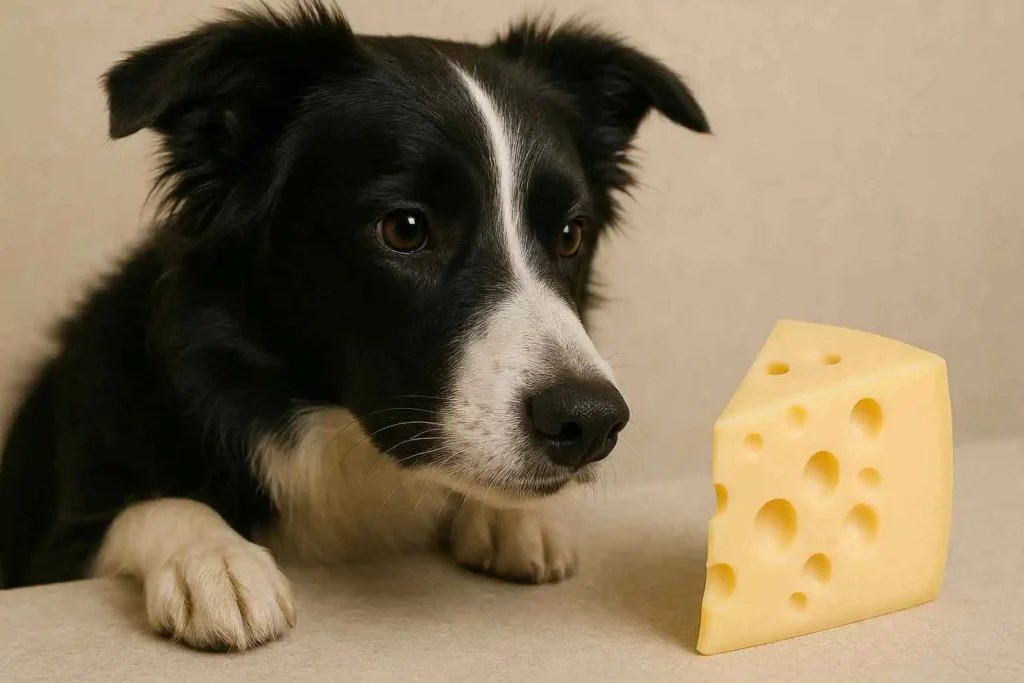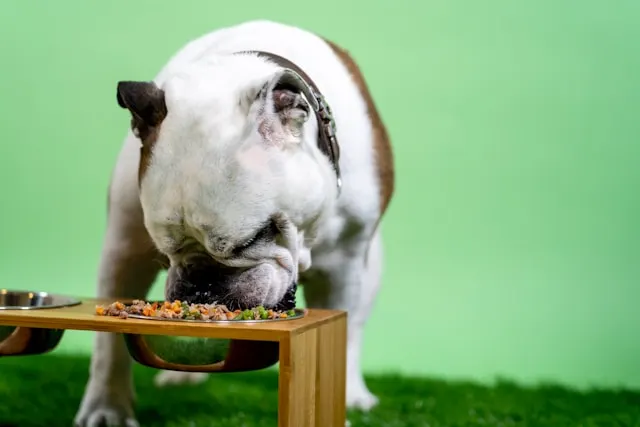You’re making a sandwich and your dog’s giving you that look—the one that says cheese is the only thing standing between them and complete heartbreak. Before you toss them a slice of cheddar, you’re wondering: can dogs eat cheese, or will it send them running for the backyard? The short answer might surprise you, but the details matter even more.
Table of Contents
Quick Answer
Yes — most dogs can eat cheese safely in small amounts, as long as it’s low-fat, low-sodium, and free of toxic additives. Moderation and type matter most.
- Best: Cottage cheese, mozzarella, plain Swiss (lower lactose)
- Avoid: Blue cheeses, garlic/onion-flavored, high-fat soft cheeses
- Rule: Limit treats (including cheese) to ≤10% of daily calories
TL;DR
Cheese is safe for most dogs in tiny amounts, but watch for digestive upset, choose low-fat options, and never exceed 10% of daily calories. Skip it completely if your dog has dairy sensitivities or health conditions.

Why It Matters
Cheese might seem harmless—it’s protein-rich, dogs love it, and it’s sitting right there in your fridge. But here’s the catch: dogs produce less lactase (the enzyme that breaks down lactose) than humans, and some don’t produce much at all after puppyhood. Feed too much or pick the wrong type, and you’re looking at diarrhea, vomiting, gas, or even pancreatitis in dogs prone to it. See more from the American Veterinary Medical Association.
On the flip side, used wisely, cheese becomes a high-value training tool and an occasional bonding moment.
The difference between “harmless treat” and “vet visit” often comes down to portion size, frequency, and knowing your individual dog’s tolerance. Understanding which cheeses are safer, how much constitutes “moderation,” and recognizing the red flags helps you make confident decisions. Dogs with existing conditions like obesity, kidney disease, or inflammatory bowel disease face higher risks from cheese’s fat and sodium content. Even healthy dogs can develop issues if cheese becomes a daily habit rather than a rare reward.
The Science Behind Dogs and Dairy
Adult dogs produce significantly less lactase than puppies, who rely on their mother’s milk early in life. Once weaned, lactase production drops, leaving many dogs partially or fully lactose intolerant.
When undigested lactose reaches the colon, bacteria ferment it, creating gas, bloating, and loose stools. The good news? Cheese contains less lactose than milk because the fermentation process converts much of it into lactic acid. Hard, aged cheeses like cheddar and parmesan have even lower lactose levels than soft cheeses.
But lactose isn’t the only concern. Cheese is calorie-dense and high in saturated fat. A single ounce of cheddar packs roughly 115 calories and 9 grams of fat—substantial for a 20-pound dog whose daily intake should only be around 400-500 calories. The sodium content in many cheeses (around 180 mg per ounce for cheddar) adds up quickly, especially problematic for dogs with heart or kidney conditions.
Brand formulas vary — always check labels for sodium and added seasonings. According to research summarized by the Tufts University Cummings Veterinary Nutrition Center, even moderate-fat cheeses can contribute to pancreatitis in predisposed dogs, making portion control essential. Some cheeses also contain ingredients that are outright dangerous. The American Kennel Club’s guidelines on cheese safety note that blue cheese varieties harbor roquefortine C, a compound that causes tremors and seizures in dogs, while cheese with added garlic, onions, or chives is toxic.
Your dog’s breed, size, age, and health status all factor into tolerance. Small breeds are more sensitive to portion errors, while large breeds might handle slightly more—but “more” is still measured in small cubes, not slices.
Choosing the Right Cheese: What’s Safe and What’s Not
Safest Options:
- Cottage cheese – Low-fat, plain (lower sodium), easier to digest
- Mozzarella – Mild, low-fat, minimal lactose
- Swiss – Generally lower lactose; sodium varies by brand; feed sparingly
- Cheddar (small amounts) – Aged varieties have less lactose but higher fat and sodium
Moderate Risk:
- Parmesan – Very low lactose but extremely high in sodium
- Cream cheese – High fat content; use sparingly for pill pockets only
- String cheese – Convenient format; serve pea-sized nibbles, not whole sticks; sodium varies by brand
Never Feed:
- Blue cheese (roquefort, gorgonzola, stilton) – Contains roquefortine C, toxic to dogs
- Cheese with herbs/seasonings – Garlic, onion, chives are poisonous
- Brie or feta – High fat, high sodium, richer texture increases upset risk
- Processed cheese products – Loaded with artificial ingredients, sodium, and preservatives
Cheese Safety: Quick Reference
| Safest Options | Avoid Completely |
| Cottage (low-fat, plain) | Blue cheeses (roquefortine C) |
| Mozzarella (low-fat) | Garlic/onion-flavored cheeses |
| Plain Swiss (lower lactose) | High-fat soft cheeses (brie, etc.) |
Tools & Products for Safe Cheese Feeding
Some products below may include affiliate links. We only recommend items we personally find safe and beneficial for dogs.
The Planet Dog Orbee-Tuff Mazee Treat Dispensing Puzzle
Planet Dog Orbee-Tuff Mazee turns cheese treats into mental stimulation. This durable puzzle toy holds small cheese cubes in its grooves, forcing your dog to work for the reward rather than gobbling it down instantly. Perfect for medium to large dogs who get overly excited about cheese and need portion control. The non-toxic material is dishwasher safe and bounces unpredictably for added play value. The downside? Small dogs might struggle with the size, and determined chewers can eventually wear down the grooves. Best for training sessions where cheese becomes the jackpot reward after problem-solving.
Wellness Soft Puppy Bites Training Treats (Cheese Alternative)
For dogs with known lactose issues, the Wellness Soft Puppy Bites offer a cheese-flavored alternative without the dairy. These grain-free, 3-calorie bites work beautifully for training without the digestive gamble. They’re soft enough for puppies and senior dogs, stay fresh in a treat pouch, and contain no artificial colors or fillers. The texture is slightly crumbly, which some dogs might drop, and they’re not quite as motivating as real cheese for picky eaters. Ideal for high-frequency training sessions where you’d otherwise blow through calories with actual cheese.
Outward Hound Fun Feeder Slo Bowl
When mixing cottage cheese into your dog’s meals for digestive support, the Outward Hound Fun Feeder slows down fast eaters who might gulp cheese-topped food too quickly. The maze pattern prevents bloat and improves digestion by extending mealtime up to 10 times. Available in multiple sizes for tiny to giant breeds, it’s dishwasher safe and made from food-safe materials. The ridges can be tricky to clean thoroughly if cheese gets stuck, and extremely flat-faced breeds might find it frustrating. Best used when introducing cheese to monitor how your dog handles it without the speed-eating variable.
Step-by-Step: How to Safely Introduce Cheese to Your Dog
Step 1: Start with a Tolerance Test
Choose a low-fat cheese like mozzarella or cottage cheese. Cut a piece the size of your pinky fingernail (roughly 1/4 teaspoon). Offer it alone, not mixed with other new foods, so you can track reactions clearly.
Step 2: Wait and Watch for 24-48 Hours
Monitor for signs of intolerance: loose stools, gas, vomiting, loss of appetite, or excessive thirst. Keep a mental note of your dog’s normal bathroom schedule to catch subtle changes. If everything stays normal, you’ve cleared the first hurdle.
Step 3: Establish Portion Guidelines
Calculate 10% of your dog’s daily calories (ask your vet or check your dog food packaging). For a 30-pound dog eating roughly 700 calories daily, cheese treats shouldn’t exceed 70 calories—that’s about half an ounce of cheddar or two tablespoons of cottage cheese. Use a kitchen scale for accuracy the first few times.
Step 4: Use Cheese Strategically, Not Routinely
Reserve cheese for high-value situations: training new commands, hiding pills, or rare special moments. This prevents your dog from expecting it constantly and keeps calories in check. If you’re training heavily, alternate cheese with lower-calorie treats to avoid overload.
Step 5: Adjust for Age and Health
Puppies under six months should generally avoid cheese since their digestive systems are still maturing and many are particularly sensitive to rich, fatty foods. If your vet approves a micro-test (a piece smaller than a pea), watch closely for any reaction. Senior dogs or those with chronic conditions need veterinary approval first. Pregnant or nursing dogs have different nutritional needs—check with your vet before adding cheese to their diet.
Step 6: Practice Safe Storage
Keep cheese in sealed containers in the fridge, out of your dog’s reach. Dogs can smell cheese through packaging and will help themselves if given the chance. Moldy cheese is especially dangerous—mycotoxins cause severe poisoning.
Step 7: Track Frequency
Use your phone or a notebook to log cheese treats for a week. You might be surprised how “occasional” adds up. If your dog gets cheese more than 2-3 times weekly, scale back to maintain the treat’s special status and avoid calorie creep.
Common Mistakes (and How to Fix Them)
Mistake 1: Using Cheese as a Daily Treat Dogs don’t need cheese every day, and regular feeding leads to weight gain and digestive adaptation problems. The fix: Rotate between different treat types—veggies like watermelon and other safe fruits, plain popcorn, or consider adding nutrient-dense superfoods to your dog’s diet instead. Save cheese for training breakthroughs or pill time only.
Mistake 2: Giving Human-Sized Portions That slice of cheese you’re eating? It’s way too much for a dog. Many owners eyeball portions rather than measuring. The fix: Pre-cut cheese into pea-sized cubes and store them in a small container. Use a measuring spoon for cottage cheese. When in doubt, go smaller.
Mistake 3: Assuming All Cheese Is Equal Blue cheese toxicity surprises many owners who don’t realize certain varieties are dangerous. The fix: Stick to the safe list (cottage, mozzarella, Swiss, cheddar) and read labels for added ingredients like garlic powder or herbs before sharing.
Mistake 4: Ignoring Lactose Intolerance Signs Mild gas or slightly softer stools get dismissed as “normal,” but they’re your dog’s body saying cheese isn’t agreeing. The fix: If you notice any digestive changes after cheese, even subtle ones, stop offering it. Dogs with recurring food sensitivities may benefit from exploring specialized diets designed for allergic dogs.
Mistake 5: Feeding Cheese to Overweight Dogs Cheese adds calories fast, sabotaging weight loss efforts without owners realizing it. The fix: If your dog is overweight, eliminate cheese entirely or use single shreds of low-fat mozzarella (under 5 calories) and reduce kibble portions to compensate.
Mistake 6: Not Accounting for Sodium Owners focus on fat and calories but overlook sodium, which stresses kidneys and hearts over time. The fix: Choose low-sodium cheese varieties when available, and factor cheese days into your dog’s overall sodium budget, especially for senior dogs.
Mistake 7: Mixing Cheese with Other Rich Foods Pairing cheese with fatty meats or giving it right after a high-fat meal increases pancreatitis risk. The fix: Offer cheese on empty-ish stomachs or alongside regular kibble, never during or after rich “people food” meals.
Troubleshooting: When Cheese Goes Wrong
If your dog has diarrhea within 12 hours of eating cheese: Withhold food for 12 hours (water only), then offer a bland diet of boiled chicken and rice for 24 hours. Skip cheese going forward—your dog is lactose intolerant. Check our complete guide to managing dog diarrhea at home safely.
If your dog vomits shortly after cheese: This suggests the fat content was too rich or the portion too large. Offer small sips of water every 30 minutes. If vomiting continues past 6 hours or you see blood, call your vet immediately. For more guidance on understanding different types of vomiting, check out our complete guide to dog vomiting and bile issues.
If your dog becomes lethargic or won’t eat the next day: This could indicate pancreatitis, especially if paired with a hunched posture or abdominal tenderness. Contact your vet same-day—pancreatitis requires medical intervention.
If your dog shows tremors, seizures, or extreme agitation after cheese: Suspect roquefortine C toxicity (blue cheese) or another toxic ingredient. This is an emergency—go to the vet or emergency clinic now.
If your dog begs incessantly after tasting cheese: You’ve created a demanding monster. Reset expectations by ignoring begging completely for two weeks while using different treats. Reintroduce cheese sparingly later.
If your dog’s stools become consistently softer over days: Even without full diarrhea, this signals intolerance. Stop cheese and switch to vegetable-based treats. Stools should firm up within 3-5 days.
When to See a Veterinarian or Pet Nutritionist
Contact your vet before giving cheese if your dog has:
- A history of pancreatitis or inflammatory bowel disease
- Kidney disease or heart conditions (sodium is a major concern)
- Obesity or diabetes (calorie control is critical)
- Food allergies or known dairy sensitivity
Seek immediate veterinary care if your dog experiences:
- Repeated vomiting (more than twice in 24 hours)
- Bloody diarrhea or black, tarry stools
- Severe abdominal pain (whining, refusing to move, hunched posture)
- Tremors, seizures, or loss of coordination after eating cheese
- Refusal to drink water or signs of dehydration (dry gums, sunken eyes)
- Lethargy lasting more than 24 hours after cheese consumption
Schedule a routine appointment if:
- Digestive upset happens every time your dog eats any dairy
- You’re unsure how much cheese is safe for your dog’s specific health situation
- You want to use cheese regularly for training and need portion guidance
- Your dog’s weight is creeping up and you suspect treats are the culprit
A veterinary nutritionist can calculate precise treat allowances and suggest safer alternatives if cheese isn’t working for your dog. The consultation fee often saves money by preventing health issues down the line. Don’t feel embarrassed asking these questions—vets would rather guide you toward safe choices than treat preventable problems.
Key Takeaways
- Feed cheese sparingly — keep under 10% of daily calories
- Low-fat, plain cheeses like mozzarella and cottage are safest
- Avoid blue cheese, flavored cheeses, and anything with garlic or onion
- Watch for digestive signs like gas, bloating, or diarrhea within 12–24 hours
- Always check with your vet if your dog has pancreatitis, kidney, or heart disease
FAQs About Dogs and Cheese
Can puppies eat cheese?
Puppies under six months should generally avoid cheese because their digestive systems are still developing and many puppies are particularly sensitive to rich, fatty foods. After six months, vet-approved micro-tests (pea-sized or smaller) might be okay, but puppy-specific training treats are the safer choice for regular use.
What cheese is best for hiding pills in dogs?
Cream cheese or soft mozzarella works best for pill pockets because they’re moldable and sticky enough to seal around tablets. Use the smallest amount necessary—about a half-teaspoon—and avoid daily pill-pocketing with cheese if possible to prevent digestive issues.
Is cottage cheese good for dogs with upset stomachs?
Plain, low-fat cottage cheese can help dogs with mild digestive upset because it’s easy to digest and provides protein. Mix one to two tablespoons with plain rice or boiled chicken. However, if your dog is lactose intolerant, skip it entirely and use plain pumpkin instead.
Can dogs eat string cheese every day?
No, dogs shouldn’t eat string cheese daily due to calorie, fat, and sodium accumulation. Reserve it for occasional treats—two to three times weekly maximum. One piece of string cheese contains 80 calories and 270 mg sodium, significant amounts for most dogs.
Why does cheese make my dog gassy?
Gas happens when your dog can’t fully digest lactose, and gut bacteria ferment it instead, producing gas as a byproduct. This indicates lactose intolerance—your dog can likely handle small amounts but not regular portions. Reduce frequency and portion size or eliminate cheese entirely.
Is lactose-free cheese safe for dogs?
Lactose-free cheese removes the lactose intolerance concern but still contains fat, calories, and sodium. It’s a better option for sensitive dogs but should still be treated as an occasional indulgence, not a dietary staple. Check labels for toxic additives before offering.
Can dogs eat mac and cheese?
Mac and cheese is too rich, salty, and processed for dogs. The combination of pasta, butter, cheese, and often added seasonings creates a recipe for digestive upset or worse. If your dog snatches a bite, they’ll likely be fine, but don’t feed it intentionally.
Wrapping It Up: The Cheese Bottom Line
Cheese can absolutely be part of your dog’s treat rotation, but only when you’re smart about it. The key is treating it like the special occasion it should be—not a daily expectation, not a generous handful, and definitely not a substitute for balanced nutrition. Most dogs tolerate small amounts of low-fat, low-sodium varieties beautifully, turning cheese into a training superpower or a sneaky pill disguise. But some dogs simply can’t handle dairy, and that’s okay. You’ve got dozens of other treat options that won’t send you both to the vet.
Pay attention to your individual dog’s signals. If cheese causes even mild digestive changes, respect that message and move on. If your pup tolerates it well, enjoy those bonding moments with tiny cheese rewards, knowing you’re staying within safe limits. When in doubt, measure portions, choose quality over quantity, and keep your vet in the loop about your dog’s overall diet. Your dog doesn’t need cheese to be happy—but used wisely, it sure doesn’t hurt to be the human with the good stuff now and then. For more guidance on safe human foods and overall nutrition, check out resources from the American Kennel Club and the American Veterinary Medical Association.
Important: This article provides educational information only and is not a substitute for professional veterinary advice or diagnosis.

